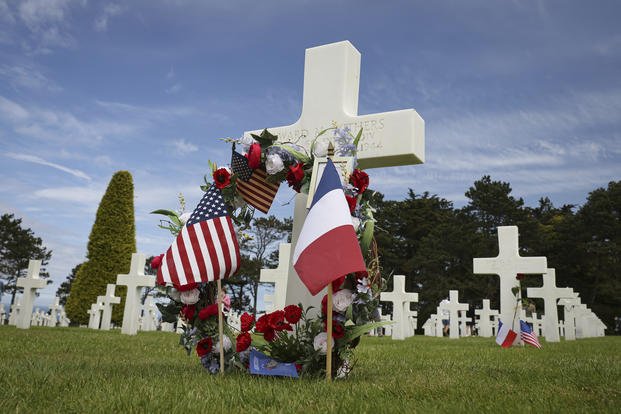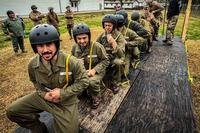At about 2 a.m. Eastern standard time on June 6, 1944, word began to filter past the censors that something big was happening in a place called Normandy.
Ships in New York harbor tooted their horns. Fireboats sent geysers into the air. In Philadelphia, the Liberty Bell was rung for the first time in more than a century.
Across the nation, people prayed for the success of the 73,000 American, 62,000 British and 21,000 Canadian forces fighting on Sword, Juno, Gold, Omaha and Utah beaches to breach Adolf Hitler's Festung Europa, Fortress Europe.
Mayor Fiorello Laguardia of New York went to Madison Square Garden to lead a prayer for victory for the GIs on what became known as D-Day, the largest seaborne invasion in history.
"We, the people of the city of New York, in meeting assembled, send forth our prayers to the almighty God for the safety and spiritual welfare of every one of you and humbly petition Him to bring total victory to your arms in the great and valiant struggle for the liberation of the world from tyranny."
At the time, one of Laguardia's constituents, 16-year-old Pvt. Joseph Leo Argenzio, of Brooklyn, who had lied about his age and was with the Army's 1st Infantry Division, the "Big Red One," had jumped over the side of the landing craft that had been met with withering fire as the ramp let down. He was saved by the dead.
"The Germans had us pinpointed," Agenzio said years later for the Veterans History Project of the Library of Congress. The water was over his head. He struggled to get to the surface as bullets hit the water and whizzed past him.
Earlier, from Southwick House in England, Gen. Dwight D. Eisenhower said, "This operation is not being planned with any alternatives. This operation is planned as a victory, and that's the way it's going to be. We're going down there, and we're throwing everything we have into it, and we're going to make it a success."
Joe Argenzio knew nothing of that.
"Why I didn't get hit, I'll never know," he said. When he got to the point where he could touch bottom, "the water was red. Bodies were floating all around." He said he pushed two of the bodies in front of him to make it to Omaha beach. "They saved my life," he said.
On the beach, "I couldn't believe what I was seeing. There was death all over the place." They had to get off the beach. Argenzio and others were rounded up on the Easy Red sector of Omaha beach by Capt. Joe Dawson. He led them up a narrow ravine, now known as "Dawson's draw," aiming to get to the top of the ridge overlooking Omaha. German mines took their toll.
Dawson threw a grenade to knock out a machine gun nest at the top. "I prayed God nobody would ever have to go through something like this again," Argenzio said.
From the White House Tuesday, President Donald Trump called on Americans to honor the troops who began the liberation of Western Europe on June 6, 1944.
"Today we remember the courage and bravery of our troops that stormed the beaches of Normandy 73 years ago," Trump tweeted over an iconic photo of U.S. troops wading ashore.
Two days earlier and not far from where Joe Dawson climbed to the ridge, Army Gen. Curtis M. "Mike" Scaparrotti, the current commander of U.S. European Command and Supreme Commander of NATO, joined with paratroops from the 173rd Airborne Brigade, the 101st Airborne Division (Air Assault), the 82nd Airborne Division and foreign militaries for a wreath-laying ceremony to mark the 73rd anniversary.
"There are moments in a nation's history when its future course is decided by a chosen few who walked bravely into the valley of the shadow of death," he said. "In such moments, young men and women pledge their lives so that their nation can live."
Scaparrotti recalled the vicious fight at Normandy from June 6-9, 1944, for a 500-foot stretch of causeway called the La Fière Bridgehead, where about 254 U.S. troops were killed and 525 were wounded.
"The Battle of La Fiere was the most significant operation of the 82nd Airborne Division during World War II," he said. "It was also the costliest small-unit action in the history of the U.S. Army."
On the Washington Mall Tuesday, a few from the remaining band of World War II veterans gathered at the World War II Memorial for a wreath-laying ceremony.
"They were willing to sacrifice everything for the greater good of humanity," Army Lt. Gen. Gary Cheek, director of the Joint Staff, said of those who hit the beach on D-Day and all World War II vets. They fought so that "others could live in a more inclusive world. It was the right and just thing to do," he said.
It was also announced at the ceremony that the Friends of the World War II Memorial were raising funds to inscribe on the Memorial the prayer President Franklin D. Roosevelt offered on national radio on June 6, 1944.
Roosevelt had spoken to the nation the night before about the fall of Rome, but "I knew at that moment that troops of the United States and our allies were crossing the Channel in another and greater operation. It has come to pass with success thus far. And so, in this poignant hour, I ask you to join with me in prayer:"
"Almighty God: Our sons, pride of our nation, this day have set upon a mighty endeavor, a struggle to preserve our Republic, our religion, and our civilization, and to set free a suffering humanity."
"Help us to conquer the apostles of greed and racial arrogancies," Roosevelt said. "Lead us to the saving of our country, and with our sister nations into a world unity that will spell a sure peace, a peace invulnerable to the schemings of unworthy men. And a peace that will let all men live in freedom, reaping the just rewards of their honest toil."
-- Richard Sisk can be reached at Richard.Sisk@Military.com.




























